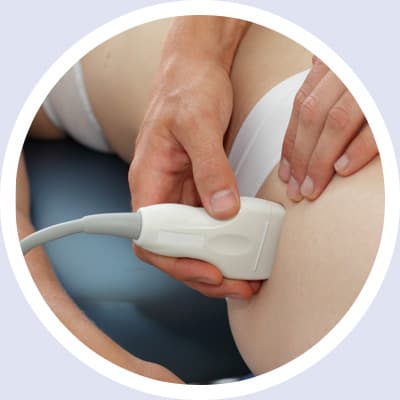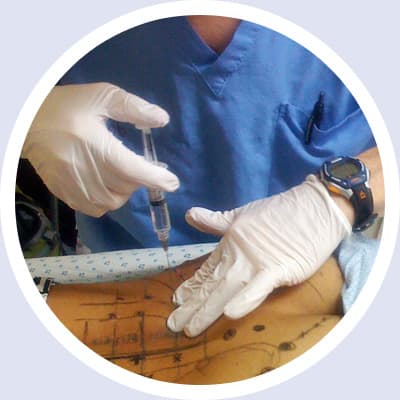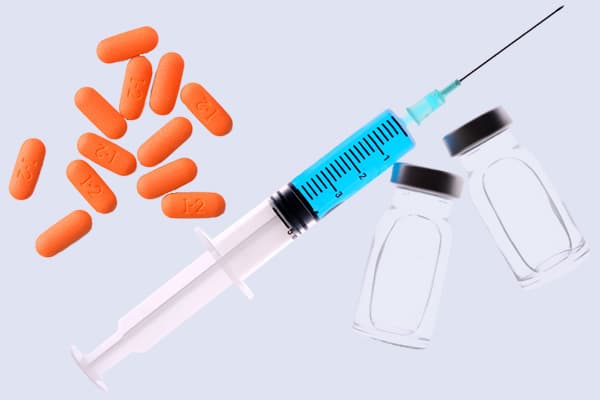Back and Hip
PAIN SOLUTIONS
Hip pain is a common complaint that can be caused by a wide variety of problems. The precise location of your pain can provide valuable clues about the underlying cause. The hip joint is where the ball of the thigh bone (femur) connects to the pelvis at a socket called the acetabulum. There is cartilage covering both the bone of the femur and the acetabulum of the pelvis in the hip joint. Injuries to the cartilage either wear and tear or traumatic injuries can lead to pain. The labrum is soft cartilage that surrounds the hip joint and provides stability. Injuries to the labrum can be traumatic or degenerative and are common source of hip pain. The ligaments around the hip joint attach the femur bone to the bony pelvis. There are a number of muscles and tendons that glide around the hip joint. Tiny fluid-filled sacs, called bursae, provide gliding surfaces for muscles and tendons around the hip joint. Trauma or wear and tear injuries to the ligaments, tendons and bursae all can lead to pain, weakness, instability of the hip joint and more pain. Problems with the hip joint result in pain in the groin and upper thigh or outer buttock. Fortunately, hip injuries are particularly responsive to regenerative medicine therapies.
Common causes of hip pain include:
Hip pain is a common complaint that can be caused by a wide variety of problems. The precise location of your pain can provide valuable clues about the underlying cause. The hip joint is where the ball of the thigh bone (femur) connects to the pelvis at a socket called the acetabulum. There is cartilage covering both the bone of the femur and the acetabulum of the pelvis in the hip joint. Injuries to the cartilage either wear and tear or traumatic injuries can lead to pain. The labrum is soft cartilage that surrounds the hip joint and provides stability. Injuries to the labrum can be traumatic or degenerative and are common source of hip pain. The ligaments around the hip joint attach the femur bone to the bony pelvis. There are a number of muscles and tendons that glide around the hip joint. Tiny fluid-filled sacs, called bursae, provide gliding surfaces for muscles and tendons around the hip joint. Trauma or wear and tear injuries to the ligaments, tendons and bursae all can lead to pain, weakness, instability of the hip joint and more pain. Problems with the hip joint result in pain in the groin and upper thigh or outer buttock. Fortunately, hip injuries are particularly responsive to regenerative medicine therapies.
Common causes of hip pain include:
Osteoarthritis of the Hip
Labral Tear
A labral tear or injury can sometimes be difficult to diagnose and therefore appropriate treatment is delayed. The gold standard for diagnosis is an MRI arthrogram of the hip joint. The cause of pain (pain generator ) is then verified by a diagnostic injection of the hip joint with anesthetic under Ultrasound Guidance.
Bursitis and Tendonitis
The hip has many tendons that connect the leg bones to the pelvis and these tendons can be injured or inflamed which leads to pain, weakness, and hip instability. The most common tendons affected include the gluteal tendons which attach to the side of the hip bone or trochanter and is frequently diagnosed as “hip bursitis”. This can cause severe pain on the outside of the hip region and cause pain with walking, going from sitting to standing and laying on the affected side.
Tendonitis of the hip is particularly responsive to regenerative medical treatments.
Snapping Hip Syndrome
Another cause is from injury to the labrum of the hip or loose cartilage.
Diagnosis is made by clinical exam and Musculoskeletal Ultrasound examination to help visualize the abnormal motion of the tendon.
Groin Pulls and Adductor Tendon Injury
This condition is typically due to degeneration of the tendon that attaches the adductor muscles to the pelvis. In some cases, the tendon is torn as well. It is a common injury in soccer and football players. This is a difficult injury to treat as it is hard to immobilize or rest it and integral to all motions of the hip and leg.
Osteitis Pubis
THE KRASNICK SOLUTION
How can Dr. Krasnick help you recover and restore naturally to health without drugs or surgery?

EXAM & DIAGNOSIS
Before a patient can be treated for hip pain, a correct diagnosis must be made.
Learn More
First, Dr. Krasnick will obtain a detailed history and perform a thorough physical examination. Frequently a musculoskeletal ultrasound will be done to understand where your hip pain is coming from. If you have any imaging studies such as X-rays, MRI or CT Scans, please bring the actual images to the appointment for Dr. Krasnick to review himself.

TREATMENT PROGRAM
Once a diagnosis is made, a comprehensive treatment program will be determined.
Learn More
This may include regenerative medical treatments such as: Prolotherapy, Platelet Rich Plasma (PRP), Stem Cell Therapy, Prolozone™, Neural Prolotherapy (Lyftogt Technique®) and Hydrodissection. None of these treatments contain any drugs, steroids, narcotics or NSAIDs, are performed in the office and do not require surgery. Dr. Krasnick performs injections under ultrasound guidance, so he is highly accurate in injecting the treatment to the exact location needed. These treatments allow the body’s own natural healing powers to recover and restore to health.

HEALTH & WELLNESS
To optimize treatment, we focus on the whole patient and not just the hip pain.
Learn More
This means Dr. Krasnick will investigate, discuss and make recommendations about your health and wellness. Important factors in order to optimize outcomes include cellular health. This entails optimizing your nutrition and diet to ensure you are getting the proper macro and micronutrients. Simple changes in diet and addition of vitamins and supplements can go a long way to improving outcomes. Dr. Krasnick will also focus on functional movement, which includes strength and flexibility. We know the body, especially, the musculoskeletal system acts as a whole and therefore pre- and post-treatment exercise or physical therapy will be recommended. Of course treatment and attention to the injured structure (joint or surrounding ligaments and tendons) will be discussed in detail, with specific post-procedure protocols when needed.
A procedure is not always needed and when possible trying to solve the problem with other noninvasive and holistic approaches will be sought.
None of the regenerative treatments contain any drugs, steroids, narcotics or NSAIDs, are performed in the office and do not require surgery. Dr. Krasnick performs injections under ultrasound guidance, so he is highly accurate in injecting the treatment to the exact location needed. These treatments allow the body’s own natural healing powers to recover and restore to health.
If you are looking for a non-surgical, drug-free, natural, alternative pain treatment for your hip pain, then contact us at (734) 585-5653 to schedule a consultation with Dr. Krasnick.
OVERVIEW OF HIP PAIN CONDITIONS
Osteoarthritis of the Hip
More About This Condition
Labral Tear
More About This Condition
A labral tear or injury can sometimes be difficult to diagnose and therefore appropriate treatment is delayed. The gold standard for diagnosis is an MRI arthrogram of the hip joint. The cause of pain (pain generator ) is then verified by a diagnostic injection of the hip joint with anesthetic under Ultrasound Guidance.
Bursitis and Tendonitis
More About This Condition
The hip has many tendons that connect the leg bones to the pelvis and these tendons can be injured or inflamed which leads to pain, weakness, and hip instability. The most common tendons affected include the gluteal tendons which attach to the side of the hip bone or trochanter and is frequently diagnosed as “hip bursitis”. This can cause severe pain on the outside of the hip region and cause pain with walking, going from sitting to standing and laying on the affected side.
Tendonitis of the hip is particularly responsive to regenerative medical treatments.
Snapping Hip Syndrome
More About This Condition
Another cause is from injury to the labrum of the hip or loose cartilage.
Diagnosis is made by clinical exam and Musculoskeletal Ultrasound examination to help visualize the abnormal motion of the tendon.
Groin Pulls and Adductor Tendon Injury
More About This Condition
The Adductor tendon connects the groin (adductor) muscles to the pelvis. Injury to the Adductor Tendon causes pain felt in the groin which can lead to weakness and reduced mobility. This is a common sports injury but can also occur from slips and falls or other trauma or overuse.
This condition is typically due to degeneration of the tendon that attaches the adductor muscles to the pelvis. In some cases, the tendon is torn as well. It is a common injury in soccer and football players. This is a difficult injury to treat as it is hard to immobilize or rest it and integral to all motions of the hip and leg.
Osteitis Pubis
More About This Condition
Traditional treatments. Have you tried them and still have pain?

Non-Steroidal-Anti-Inflammatory-Drugs (NSAIDS) such as Ibuprofen, Advil and Motrin can temporarily relieve hip pain, but also reduce the cells that are needed to repair damaged tendons and ligaments and this can lead to more instability and pain! NSAIDS can also lead to bleeding in the stomach, ulcers and kidney damage. Narcotics are also used but can lead to side effects of constipation and drug dependency. For some patients, surgery is considered, but has greater risks such as infection or more pain.
